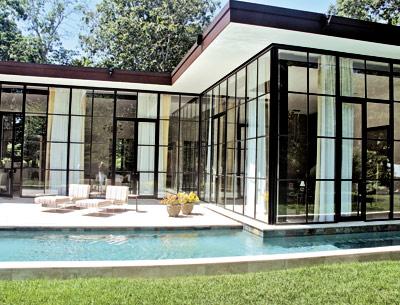Open But Enclosed, For All Seasons

Remember when Grandma used to talk about how they did it in the old days, pulling shut all the drapes and leaving them shut when the sun came up and how that kept the house cool all day? Michael Haverland does. The architect not only uses floor-length drapes — two-sided for insulation — in his own house on Cove Hollow Road in East Hampton, he urges them on his clients all the time, he said on a Friday in late July. It’s one example of his belief that simple, practical solutions are best.
With the house’s 12-foot ceilings and walls of glass, he really needs those drapes. As if the walls weren’t dazzling enough, the drapes add drama, recalling as they do a movie theater. In this case, what they open to reveal is an expanse of travertine patio, the waters of a 25-meter lap pool as narrow as a moat, and a lush lawn giving onto an explosion of tall foliage.
Mr. Haverland scouted out land by bicycle and eventually came upon a deep flag lot where he could let his designer’s hair down. “It’s horrible. I don’t think I can live here,” his partner, Philip Galanes, said when he saw the property. “You’d better make it good.” Mr. Galanes, an entertainment attorney and novelist, perhaps best known as the “Social Q’s” columnist for The New York Times, is also an interior designer and furniture collector.
“The goal was to build a glass box to hold all his furniture,” Mr. Haverland said, laughing. He built the 3,000-square-foot house, which has the feel of a loft dropped to the first floor, in 2004. It was the first of a half dozen projects he has completed here. “I’m lucky it was good,” he said, explaining that it has become something of model. “I’ve had people ask me if it’s from the 1960s. I’m happy about that; it can’t be dated.”
“The question was how to make a modern house that doesn’t feel like a California modern house. You can’t transplant a style to a different environment. My work out here is connected here, and every project is different — true to the site and to the client.”
He’s in the early design stage for a house in Beverly Hills. “Everything is different there — the light, the heat. It doesn’t cool off at night in the same way. In that climate you can do more indoor-outdoor living. There are really only two months you can do that here. We rarely use the double doors or open up the entire house. . . . But even in bad weather, it’s bright and cheery.”
“The windows echo the French architecture of the 1940s and ’50s, or the factory windows of New England,” Mr. Haverland said. The expanse of glass is broken up by steel mullions into 30-by-37-inch panes. The mullions are thin, which required tricky engineering, yet somehow they feel sheltering. “You get a sense of enclosure from them,” he said. “It’s modern yet cozy.”
If Mr. Haverland, who taught urban design at Yale for 10 years, has an architectural philosophy, it is that “simple forms are easier to build and more economical.” Thus the work “becomes more about the proportion of the space, rather than establishing interest through sculptural space. A designer has a choice: Form? Or texture and details?”
Among the details in the East Hampton house are a Victorian-era oak door, metal doorknobs from an 1898 school, and old-fashioned push-button light switches — one for on, one for off. “It’s simple, tactile.”
As are two museum-style partitions inventively placed in the open floor plan between the dining and living room areas. Toward the rear of the living space, the ceiling drops to 10 feet in the bedrooms.
Mr. Haverland’s office, tucked between the main room and the bedrooms, has a splash of color courtesy of a pink leather Eames chair commissioned by Mary Kay, the cosmetics magnate. Personal effects include an early mockup of Mr. Galanes’s column and sketches by Robert Venturi, the influential architect and writer. Mr. Venturi became a mentor when Mr. Haverland worked for him in Philadelphia for a time.
Mr. Venturi is a fan of an East End landmark, the Big Duck in Flanders, and in his book “Learning From Las Vegas,” published in the 1970s, he used it in positing a theory that architecture can be divided into two categories, ducks and decorated sheds. Is it, in essence, an artistic expression, or is it functional?
“The best architecture is anachronistic,” Mr. Haverland said. “It can live through cycles of style and taste.” The South Fork’s traditional Shingle Style, for instance, “transcends trendiness — when done well. What you see being built out here is a hybrid of the old and the new, but often you get the worst of both.”
In his practice he has a hand in everything, soup to nuts, often with a couple of projects in the works at once. While he may have a predilection for vast banks of windows, he said he has no signature style and is always looking to branch out. Now that he’s here nearly all the time, he said he would enjoy doing a Shingle Style house from scratch. Maybe show them how it’s done.
Marco Zanuso chairs in the living room are covered in blue velvet.
A partition that walls off the dining area is hung with a Leo Bersamina work of photographic portraits cut into starburst shapes.
A watercolor by Robert Harms of Southampton adorns a wall of the main bedroom.
On the other side of the dining area, a second partition shows another work by Robert Harms.
